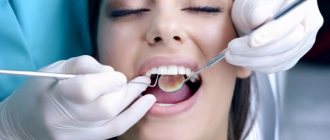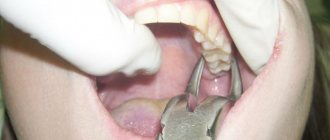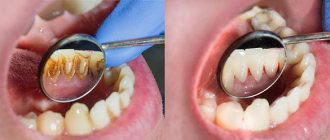Reasons for appearance
In medicine, a hole in the gum is called a fistula. A fistula appears as a consequence of the activity of harmful microorganisms that are located in the area of the alveolar process. As a rule, the causative agents of pathology are coccus bacteria.
That is, the main reason for the formation of a fistula is a large amount of pathogenic microflora in the mouth. Lack of hygiene, the accumulation of soft plaque and the formation of tartar provoke the appearance of a fistula in the gums. Over time, tartar grows and begins to put pressure on the gums. In addition, soft dental deposits spoil the aesthetics of a smile; pigment spots may appear on the enamel.
Another reason for the appearance of a fistula near a tooth may be infectious inflammation. Diseases such as tonsillitis, ARVI, and whooping cough reduce immunity, creating all the conditions for the proliferation of bacteria.
Symptoms
This complication has very pronounced symptoms.
- Pain.
Many people perceive pain as a standard consequence of tooth extraction. This is partly logical, but over time the pain does not stop and only gets stronger. This is a clear sign of a complication. - Swelling and inflammatory process.
A tooth fragment injures soft tissues, causing swelling and inflammation. The longer you delay treatment, the stronger the inflammation. - A characteristic coating in the area of the hole.
Appears at a later stage, when the body tries to fight the inflammatory process. - Pus and bad breath.
A late stage complication that requires immediate intervention.
Fistula in the soft periodontal tissues after tooth extraction
The formation of a hole after tooth extraction is normal. As a rule, the hole heals within one to two weeks. If the operation was performed on wisdom teeth, the tightening process may take several weeks. Impaired socket tightening can occur due to infection or in case of injury to the area where the tooth was removed.
In a situation where the hole has tightened and a gap has formed in the periodontium, it may indicate that the tooth was not completely removed. Small fragments of the tooth gradually begin to decompose, forming a fistula.
What can you do to speed up the healing process?
Only “sterile conditions” in the oral cavity will allow the wound to heal quickly, although this is a rather relative concept. There are both harmful and beneficial bacteria in the mouth. In addition, internal diseases can sometimes negatively affect the gum healing process:
- intestinal dysbiosis;
- pathological phenomena in the gastrointestinal tract, esophagus.
The main thing is to prevent the development of secondary infection of the hole, adhering to certain rules so that the wound heals and heals. So, you need to do the following:
- hold the gauze swab placed in the hole by the doctor more tightly in the first few hours after tooth extraction, squeezing with the jaws;
- stop smoking, drinking alcohol and hot solid foods for the first 2-3 days until the healing process and formation of new bone takes place;
- do not wash out blood clots, which create a kind of plug (protection) from the penetration of harmful bacteria and microorganisms;
- avoid accidental injury to the socket, i.e. it is better to chew food on the other, healthy side;
- stop playing sports, visiting saunas and overheating in the sun for 3-4 days;
- It is advisable not to sleep on the sore side of the jaw in the first days;
- rinse your mouth with herbal decoctions, although doctors do not recommend doing this to avoid washing out blood clots.
Often, out of ignorance and mistake, patients begin to vigorously rinse their mouths with various traumatic means at hand (soda, salt, hydrogen peroxide) so that the hole space heals faster, thereby aggravating the process and significantly delaying the healing time of the hole. All that happens is irritation, destruction and washing out of blood clots, and increased pain. All this may be a reason to return to the dentist and perform a secondary operation.
Of course, some adherents of traditional medicine try to minimize unpleasant symptoms using herbal infusions, decoctions and lotions. Dentists approve ointments and gels with anti-inflammatory and wound-healing effects so that the wound begins to heal faster.
The main thing is not to neglect the frequency and duration of home treatments. You can make gentle infusions and lightly rinse your mouth to remove food particles after each meal. Although in the first days it is extremely undesirable to do this. Such leaching can lead to the liquefaction of blood clots, a process of “gurgling” in the mouth.
You can use weak solutions of herbal decoctions (chamomile, sage) or Furacilin, Chlorhexidine, as pharmaceuticals. It is better to first consult a doctor and apply it carefully, without overdoing it, so that the healing of the hole occurs comfortably and gradually.
Fistula between tooth and gum
A hole between a tooth and periodontal tissue indicates the development of cervical caries or the complications it caused. Cervical caries can be located between the teeth and not be visible to the naked eye. Due to its inaccessible location, such caries often turns into pulpitis.
Pulpitis is an inflammation of the blood vessels and nerve endings located in the pulp chamber of the tooth. The chronic stage of the pathology may be accompanied by the formation of a purulent focus in the soft tissues. If pulpitis progresses to the next stage of periodontitis, several fistulas may appear at once.
What does gum healing depend on?
Removing the eighth teeth is particularly difficult due to the incorrect location, which occurs in 80% of people. Accordingly, the postoperative period lasts a longer period of time. The process of tissue repair depends on the following factors:
- Traumaticity of surgical intervention;
- Size and location of the eighth tooth;
- State of the immune system;
- Patient's age;
- Presence of chronic diseases;
- Individual characteristics;
- Taking medications;
- Presence of seams.
The appearance of a hole in the periodontium in a child
The formation of a hole in the gum near a tooth in a child can be due to reasons such as: periodontitis caused by complicated caries, or injury to the oral mucosa. With periodontitis, the lesion reaches the jaw bone. A cavity appears inside the periosteum, which is filled with pus. When there is an excess of pus, it breaks out through the fistulous tract, thereby bringing severe pain.
Frequent mechanical damage to the mucous membrane and gums causes infection to enter the oral cavity. Bacteria entering the periodontium cause inflammation and fistula formation.
Complicating factors
The extraction procedure itself is ordinary and highly predictable, given the level of modern dentistry and the technological equipment of clinics. Nevertheless, even such manipulation has complications, especially if you take it lightly. It is worth taking into account that each clinical case is individual: if in one case tooth extraction is not very difficult, then in another the dental surgeon has to apply all his skills and use advanced technologies and equipment in treatment. It is no coincidence that the price lists of clinics include the item “Complicated tooth extraction”: you have to pay more for this service. Experts identify several factors that can lead to complications, including fragments in the socket.
- Wisdom teeth.
Because of their remoteness, default eights are quite difficult to remove. They often grow incorrectly or do not fully erupt, which increases the risk of complications during removal. - Retention.
A tooth that has not fully erupted, when only part of the crown is visible above the gum or is completely hidden in the soft tissues. - Dystopia.
The tooth erupts at the wrong degree and abuts its neighbors. - The tooth is severely damaged due to trauma.
In such a situation, when removed, it may crumble, and some of the fragments will remain in the hole.
Symptoms
Signs of fistula formation include:
- aching pain that increases in the evening;
- burning and itching of gums;
- swelling in the affected area;
- gum hyperemia;
- increased body temperature;
- general weakness, chills;
- increased irritability;
- apathy.
The appearance of symptoms of pathology is individual for everyone. Some may experience very severe pain and discomfort in the mouth, while for others the symptoms may be almost invisible.
Symptoms of alveolitis
As a rule, the patient ignores the first symptoms of inflammation without due attention, considering them to be the norm after surgery. After tooth extraction, as already noted, pain within 24 hours is considered normal. As the hole heals, the pain subsides and completely disappears after a few days.
If the patient develops an inflammatory process, then the unpleasant sensations do not subside after a day or two, and 3–5 days after the operation, severe, throbbing pain in the socket occurs, which intensifies as the infection develops.
With alveolitis, patients may complain of both unbearable and moderate pain. Pulsation and pain are focused, as a rule, only in the removal area. However, in rare cases, the pain radiates to half of the face.
Other characteristic symptoms of alveolitis are:
- a sharp rise in body temperature;
- tooth sensitivity to hot/cold food;
- enlargement of the submandibular lymph nodes;
- decreased appetite;
- increased salivation.
In rare cases, the disease causes weakness, increased fatigue, and secondary infectious foci appear on the oral mucosa.
Treatment
If you find a fistula on the gum, you should immediately go to see a dentist. Based on the diagnosis and identification of the causes of the disease, appropriate treatment is prescribed.
Treatment can be carried out in two ways:
- drug treatment;
- surgical treatment.
If the cause of the formation of a fistula is a carious process or pulpitis, then the following treatment is carried out:
- destroyed dentin is removed;
- The cavity is processed and a filling is applied.
Then, to eliminate inflammation and remove pus, the following is prescribed:
- rinsing with antiseptics;
- antiseptic and analgesic gels and ointments;
- Antibiotics may be prescribed if necessary.
If the cause of the hole is periodontitis or an infection that has penetrated into the root of the tooth, surgical intervention is performed.
In the first case, the fistula is opened, the accumulated pus is removed through drainage, and the cleaned hole is treated with antiseptics and covered with a medicinal bandage.
When an infection occurs, not only the gums are opened, but also the alveolar process. After treatment of the tooth root, bone augmentation is performed. If the root is severely damaged and cannot be treated, the tooth must be removed.
How is tooth extraction performed?
It all starts with a consultation. The doctor will take a three-dimensional photograph, assess the location of the tooth in the jaw, the number and direction of the roots - wisdom teeth are famous for their unusual anatomy. All other human teeth are classified and have their own standard structure options, while the shape of wisdom teeth is random.
By the way, why wisdom? The point is the timing of the formation of tooth germs. All other teeth are formed in utero and after birth only continue their development and eruption. The formation of figure eights in the jaws occurs at the age of 4-5 years, and the beginning of teething occurs at an older age, hence the connection with wisdom.
After assessing the situation based on the image, you will be scheduled for surgery. At the appointment, the doctor administers anesthesia and removes the tooth. Most often, you need to make a small incision in the gum and cut the tooth into several parts; you can read more in detail here.
After removal, the additional incision is sutured, but the hole itself remains. The doctor inserts a membrane made from the patient’s venous blood into it - before the operation begins, the blood is taken and the tube is sent to a centrifuge, where the membrane is formed. Experience has shown that this will heal better and faster. A blood clot forms in the hole with the membrane, through which it will heal.
Prognosis and possible complications
If the fistula is detected and treated in a timely manner, the prognosis is favorable. If you follow all the specialist’s recommendations, within a week the resulting wound will completely heal and heal.
If proper treatment is not carried out, the following consequences are possible:
- abscess formation;
- phlegmon;
- osteomyelitis;
- tooth loss.
Preventive measures
- regular teeth cleaning;
- carrying out professional hygiene in the dental office;
- preventive examinations by a dentist every six months;
- daily consumption of fruits and vegetables.
What to do if the tooth is not completely removed?
If a piece of a tooth or part of a root remains after removal, and the doctor did not notice it, then sooner or later the symptoms described above will appear. What to do if a tooth is pulled out and a fragment remains? First of all, there is no need to panic. A regular x-ray can detect the presence of foreign bodies, including remaining fragments. In most cases, tooth removal does not take much time and is performed using standard surgical techniques. If the case is complex, an incision of the mucosa may be required. Today there are advanced surgical treatment techniques, such as laser surgery. Thanks to this, in difficult cases it is possible to reduce the invasiveness of the intervention. Be that as it may, for a qualified dentist, coping with the complication will not pose any great difficulties. The main thing is to contact him in time.
Many people are interested in whether the tooth root can come out on its own. If after removal part of the root remains in the gum, then you definitely shouldn’t count on it. Sometimes a tooth fragment may come out on its own, but there is no need to hope for this either. Moreover, you should not try to remove a tooth fragment from the socket yourself. You will most likely hurt yourself even more. If you notice remains of a tooth in the hole, go to the doctor immediately.
Treatment of alveolitis
When the socket becomes inflamed, the main thing is to eliminate the source of infection, prevent the development of inflammation and preserve the dentition. In order to alleviate the patient’s condition, the dentist uses the following therapy methods:
- Mechanical cleansing of the hole, washing out purulent residues with a solution of nitrofural or hydrogen peroxide.
- Anesthesia of the hole. The pain syndrome is relieved with the help of local applications with anesthetics and analgesics. To do this, the doctor applies the lotion for half an hour and then removes it to prevent the proliferation of microbes in the area. The dentist will advise the patient to repeat the procedure several times a day. Taking painkillers orally is not recommended.
- Taking antibiotics. In the presence of concomitant diseases, alveolitis is treated with antibiotics.
With the right approach, the signs of alveolitis subside 2-3 days after the start of treatment. If therapy was not started on time, residual pain may drag on for 2–3 weeks.
With the permission of the dentist, additional treatment of alveolitis with folk remedies is possible:
- Sage rinses. To prepare the solution, brew a large spoonful of dry sage in 250 ml of boiling water, leave the mixture for an hour, wrapping the container in a towel. After this, the liquid should be filtered and used for rinsing.
- Gargling with chamomile flowers. To prepare the composition, brew a large spoonful of chamomile flowers in a glass of water for 15 minutes, insulating the container with a towel. The infusion should be strained and rinsed your mouth up to 12 times a day.
- Poplar buds. To prepare, take half a glass of buds, pour into a glass container and pour in 500 ml of vodka. The product should be infused for 10 days in the dark and cool, then filtered, soaked in cotton swabs and applied to the inflamed area.
- A soda rinse solution can also be an effective addition in the treatment of alveolitis. You should take a large spoonful of powder in a glass of warm water or mix soda with water to obtain a paste-like mass, which then needs to be used to treat the hole.
- Burdock leaves. To prepare a medicinal decoction of burdock leaves, you need to pour 20 grams of raw material with 2 glasses of water, and then simmer the mixture over low heat for about 40 minutes. The resulting solution should be cooled and filtered, and then used for rinsing.
- Aspen bark. Pour 1 tablespoon of crushed aspen bark into one glass of boiling water. It is important to leave the solution in an airtight container for 3 hours, and then use 100 ml of strained warm liquid at least 3 times a day.
- Anise infusion. To prepare the infusion, pour 1 tablespoon of anise into 200 ml of boiling water, and then keep in a thermos for 50 minutes. The liquid should be filtered and used to rinse 3 times a day.











